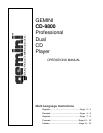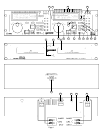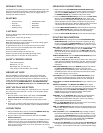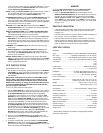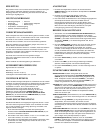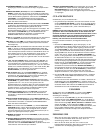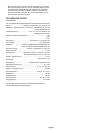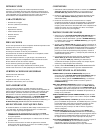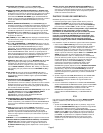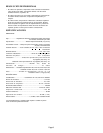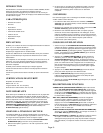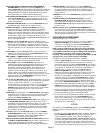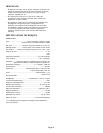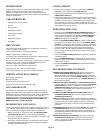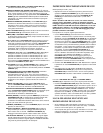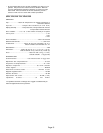Page 3
+/-8% to the pitch control slide. The 16% button will assign +/-16% to
the pitch control slide. The PITCH CONTROL (13) must be ON for
the 4%, 8% and 16% BUTTONS (12) to work.
PITCH
: Pushing the PITCH CONTROL (13) activates the pitch section of
the unit (pitch LED glows red). The pitch of the CD will change
according to the position of the PITCH CONTROL (13).
PITCH BEND BUTTONS
: Pushing the PITCH BEND BUTTONS (14) will
automatically raise or lower the pitch +/-4%, 8% and 16% without
changing the slide setting. Releasing the buttons will return the pitch
to the slide setting. You can use this function to match the pitch bend
when mixing from one song to another.
SET CUE
: Use the SET CUE (15) button to activate the DIRECT
ACCESS BUTTONS to set a CUE POINT. See the CUE INSTRUC-
TIONS section for more information.
DIRECT ACCESS BUTTONS
: Use the DIRECT ACCESS BUTTONS
(16) to select what track to play and to set a CUE POINT. See the
CUE INSTRUCTIONS section for more information.
SINGLE
: Pressing the SINGLE (17) button will activate the AUTO CUE
FUNCTION and cause the unit to stop at the beginning of music of
the following track. This allows you to start play immediately from the
start of music without any blank space (which exists at the beginning
of every track).
CONTINUE
: The CONTINUE (18) function will cause the unit to play
continuously.
PLAYBACK DISPLAY
: The PLAYBACK DISPLAY (19) displays the
time remaining to play and flashes slowly when the track has 15
seconds left. The PLAYBACK DISPLAY (19) flashes quickly when
the track has 5 seconds left.
DIGITAL OUTPUT JACK
: Connecting any type of DAT, MD, HARD
DRIVE, or other such items which accept digital signals into the BNC
CONNECTOR (24) on the rear panel of the transports allows you to
receive a digital signal from CD.
CUE INSTRUCTIONS
Special Mode for CUE 1 (only):
1. Play the track you wish to play, push pause and move the SEARCH
JOG WHEEL (7) to the exact point you wish play to begin, and then
PLAY/PAUSE BUTTON (5) to memorize the CUE 1 POINT (CUE 1
LED will blink).
NOTE: When a CUE LED is not lit, there is no CUE POINT saved in
memory. When a CUE LED is blinking, the unit is ready for you to
change the CUE POINT. When a CUE LED stays lit, there is a CUE
POINT saved in memory. To change the saved CUE POINT you have
to press this CUE BUTTON (the CUE LED will then blink) and then
you can change the CUE POINT.
To set a cue point, follow these instructions:
1. Use the TRACK SKIP (6) to find the track you wish to play. Listen to
the track and when the track gets to the approximate spot, push the
PLAY/PAUSE BUTTON (5), and if the cue LED is not blinking
(indicating the unit is ready for you to set the cue) press the CUE
BUTTON you wish to assign the cue to (CUE 1 or CUE 2), than you
must touch the SEARCH
JOG WHEEL (7) to fine tune the memo-
rized cue point, adjusting the CUE POINT forward or backward. The
unit will go into CUE MODE (cue LED will be lit) and the location
indicated on the display will be the memorized cue point. Push the
PLAY/PAUSE BUTTON (5), and the unit will instantly play from the
spot selected. If you don’t want to memorize the adjusted CUE
POINT, after touching the SEARCH
JOG WHEEL (7), push the CUE
BUTTON (with the blinking LED) and then the PLAY/PAUSE
BUTTON (5). While in play mode, pressing the CUE BUTTON will
pause the play and bring you back to the CUE POINT.
2. Press the second CUE BUTTON from PLAY MODE ONLY and
repeat the process with the second CUE BUTTON, to set a second
CUE POINT.
3. To preview a CUE POINT, from PLAY MODE press PLAY/PAUSE
BUTTON (5), and then press and hold down the CUE BUTTON to
preview the CUE. Letting go of the CUE BUTTON will bring you back
to the CUE POINT and PAUSE MODE.
AND/OR
To use the SET CUE BUTTON (15) and the DIRECT ACCESS
BUTTONS (16) to set a cue point, follow these instructions:
1. Press the SET CUE BUTTON (15) (the LED will light). Use the
DIRECT ACCESS BUTTONS (16) to memorize the spot at which you
want play to start, the CUE POINT, by selecting the proper track,
minute, second and frame. Press CUE 1 to set the cue to CUE 1
(press CUE 2 if you wish to set the cue to CUE 2). You can do this in
any mode, including PLAY MODE, so that you may cue a track while
playing a track.
TROUBLE SHOOTING
• If THE DISC WILL NOT PLAY, check to see if the disc was loaded
correctly (written side up). Also check the disc for excessive dirt,
scratches, etc.
• If the disc turns but there is no sound, check the cable connections. If
they are okay , check your amplifier or receiver.
• If the CD skips, check the CD for dirt or scratches. Do not assume
that the CD player is defective. Many CDs are recorded out of spec
and will skip an most or all CD players. Before sending the unit in for
repair, try playing a CD that you are sure plays properly.
SPECIFICATIONS
GENERAL:
Type.....................Dual Mechanism Compact Disc Player w/wired remote
Disc Type..................................Standard Compact discs (12 cm & 8 cm)
Time Display....................Track Elapsed, Track Remain, or Total remain
Variable Pitch....................± 4%, ± 8%, ±16% Slider with Resume Switch
Pitch Bend.........................................................................................±4%
± 8%
± 16%
Instant Start.............................................................Within 0.03 seconds
Track Selection..................................................................1 to 99 Tracks
Installation......................................19" Rack Mountable Player Unit, 2 U
19" Rack Mountable Control Unit, 3 U
Power Supply.......................................................AC 120/230V, 50/60 Hz
Power Consumption..........................................................................16W
Dimensions...................................Player Unit 19” (W) x 3.5" (H) x 10" (D)
Control Unit 19” (W) x 5.2" (H) x 2.9" (D)
Weight...........................................................Player Unit 11.7 lbs (5.3 kg)
Control Unit 3.8 lbs (1.7 kg)
AUDIO SECTION:
Quantization......................................1 Bit Linear/Channel, 3 Beam Laser
Oversampling Rate.......................................................................8 Times
Sampling Frequency..................................................................44.1 kHz
Frequency Response.......................................................10 Hz to 20 kHz
Digital Output................................................................................IEC908
Total Harmonic Distortion..............................................Less Than 0.05%
Signal to Noise Ratio.....................................................................104 dB
Dynamic Range...............................................................................98 dB
Channel Separation.............................................................90 dB (1 kHz)
Output Level....................................................................1.9 Volts R.M.S.
* Specifications and design are subject to change without notice for
purpose of improvement.



